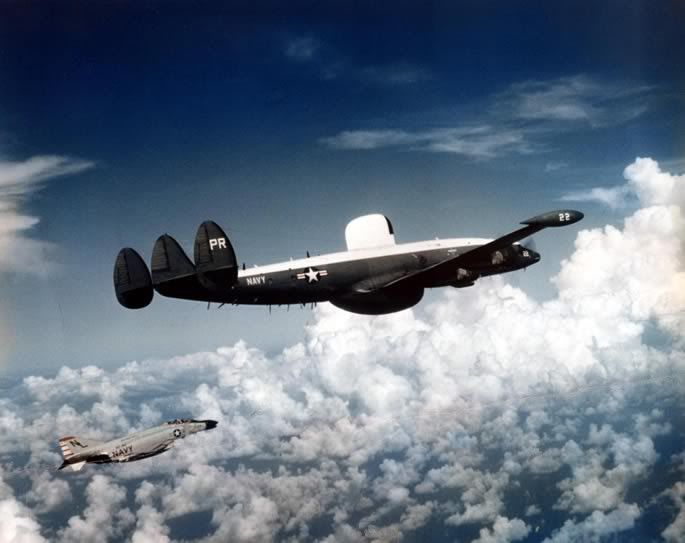Yep this got your attention. Gotta love those Russian built Migs.The incident. The EC-121 shootdown incident occurred on 15 April 1969 when an United States Navy Lockheed EC-121M Warning Star on a reconnaissance mission was shot down by North Korean MiG-17 aircraft over the Sea of Japan. The plane crashed 90 nautical miles (167 km) off the North Korean coast and all 31 Americans on board were killed.
The Nixon administration chose not to retaliate against North Korea.
To me, this single act of war with loss of life was probably the start of North Korea as the modern rogue nation. ie 'Get away with this and get away with anything'. AVIATOR
At 07:00 local time of Tuesday, 15 April 1969, an EC-121M of the U.S. Navy's Fleet Airborne Reconnaissance Squadron One (VQ-1) took off from NAS Atsugi, Japan, on an intelligence-gathering reconnaissance mission. The aircraft, Bureau number 135749, c/n 4316, bore the tail code "PR-21" and used the radio call sign Deep Sea 129.
Aboard were 8 officers and 23 enlisted men under the command of LCDR James Overstreet. Nine of the crew, including one Marine NCO, were Naval Security Group cryptologic technicians (CTs) and linguists in Russian and Korean.Deep Sea 129's assigned task was a routine Beggar Shadow signal intelligence (SIGINT) collection mission. Its flight profile northwest over the Sea of Japan took it to an area offshore of Musu Point, where the EC-121M would turn northeast toward the Soviet Union and orbit along a 120-nautical-mile (222 km) long elliptical track.
LCDR Overstreet's orders included a prohibition from approaching closer than 50 nautical miles (90 km) to the North Korean coast. VQ-1 had flown the route and orbit for two years, and the mission had been graded as being of "minimal risk." During the first three months of 1969 nearly 200 similar missions had been flown by both Navy and U.S. Air Force reconnaissance aircraft off North Korea's east coast without incident.
The mission was tracked by a series of security agencies within the Department of Defense that were pre-briefed on the mission, including land-based Air Force radars in Japan and South Korea.
Interception and shootdownAt 12:34 local time, roughly six hours into the mission, the Army Security Agency and radars in Korea detected the takeoff of two North Korean Air Force MiG-17s and tracked them, assuming that they were responding in some fashion to the mission of Deep Sea 129. In the meantime the EC-121 filed a scheduled activity report by radio on time at 13:00 and did not indicate anything out of the ordinary. 22 minutes later the radars lost the picture of the MiGs and did not reacquire it until 13:37, closing with Deep Sea 129 for a probable intercept.
The communications that this activity generated within the National Security network was monitored by the EC-121's parent unit, VQ-1, which at 13:44 sent Deep Sea 129 a "Condition 3" alert by radio, indicating it might be under attack. LCDR Overstreet acknowledged the warning and complied with procedures to abort the mission and return to base.
At 13:47 the radar tracks of the MiGs merged with that of Deep Sea 129, which disappeared from the radar picture two minutes later.
Search effortsA search and rescue effort was immediately launched by VQ-1 using aircraft of both the U.S. Air Force and Navy. The first response was by an Air Force Lockheed HC-130 Hercules, with a Boeing KC-135A Stratotanker tanker in support and an escort of fighters, but the search effort rapidly expanded to a total of 26 aircraft. At short notice, two U.S. Navy destroyers, USS Henry W. Tucker and USS Dale, sailed from Sasebo, Japan.
The first debris sighting occurred at 09:30 the next morning a that evening Tucker arrived in the area and after midnight recovered part of the aircraft perforated with shrapnel damage.
At approximately noon of 17 April Tucker recovered the first of two crewmen's bodies, then rendezvoused with the Soviet destroyer Vodokhnovenny (D-429) and sent over her whaleboat. The Soviets turned over all of the debris they had collected. The bodies of Lt.j.g. Joseph R. Ribar and AT1 Richard E. Sweeney were taken to Japan but those of the other 29 crewmen were not recovered.
North Korea publicly announced that it had shot down the plane, claiming it had violated its territorial airspace and shot the aircraft down as a birthday present for their President.
Of note, April 15 was the birthdate of the North Korean dictator Kim Il-Sung.

